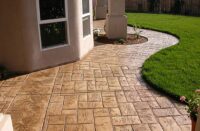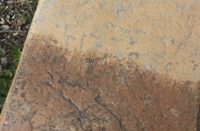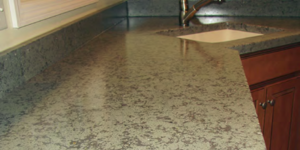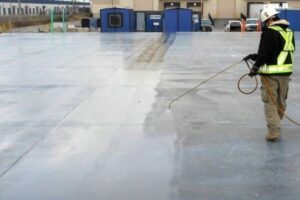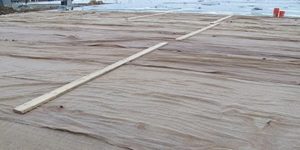Question
I recently applied a two-part polyurethane sealer over a stained concrete floor. The sealer’s application instructions said to apply the second coat after the sealer was “tack-free” or between 4 and 8 hours after applying the first coat. What does tack-free mean? Can you explain the difference between drying sealers vs curing sealers? Why do I have to wait, and what if I apply the second coat the next day?
Answer
Sealers and coatings, for the most part, go through the same phases as they dry and/or cure. Before explaining these phases, you need to know that while all sealers and coatings dry, some also cure as they dry.

With the exception of 100 percent solids coatings, sealers and coatings contain liquid solvent called the carrier. Popular solvent carriers include water (yes, chemists consider water a weak solvent), acetone, xylene, tertiary butyl acetate (known as TBAc), Aromatic 100 and others. Solvents other than water are usually blended together to achieve a desired drying time.
The type and amount of solvent will play a big part in how easily you can apply the sealer, how it lies down and how fast or slow it dries. Typically, one-part sealers dry without curing. Once applied to the surface, the liquid carrier evaporates into the air, while the resin or solids portion of the sealer forms a film, allowing the whole system to dry.
With two-part coatings, sometimes referred to as catalyzed systems, drying and curing occur. Curing refers to the chemical reaction that takes place between the different parts mixed together, also commonly called crosslinking. I often compare crosslinking to a bowl of spaghetti with all those intertwined noodles forming a dense, not easily pulled apart network. Crosslinking is what gives two-part systems added durability and chemical resistance. Manufacturers often label these products “high-performance coatings.”
Drying sealers vs curing sealers
Another place where drying versus curing affects our industry is when you reseal or repair something. Sealers that dry, and are based on solvents other than water, reliquefy when solvents are applied to them. Coatings that cure are not affected when solvents are applied. This is why one-part, solvent-based sealers — typically acrylics — are easier to repair and recoat without much preparation. Solvents reliquefy the previous layer of sealer, allowing for easy recoat or repair. Before reapplying, you must sand or screen water-based sealers or two-part coatings that don’t reliquefy by solvent contact. In a worst-case scenario, you must remove the sealer by a chemical or mechanical process.
Having a basic understanding of drying versus curing makes it easier to explain the different phases sealers and coatings go through.
Phases of sealers and coatings
Shelf Life
This is the length of time a product will last in a container when stored airtight between 50 and 90 degrees Fahrenheit. Most manufacturers offer a one-year shelf life on sealers or coatings. Two-part systems tend to be more sensitive than one-part systems when it comes to shelf life but, if stored properly, most sealers and coatings will last well past a year.
Pot Life
Also called “working life,” this is the phase when the sealer or coating is applied. Once the sealer or coating containers are opened, the required mixing is done and the product is applied. The term comes from the lifespan of the product in the “pot,” which is typically a pail or bucket. The length of “pot life” depends on the sealer or coating’s chemistry. Environment also affects it, especially temperature. Heat is a catalyst. So the warmer the conditions, the faster the product reacts or dries and the shorter its “pot life.”
Open Time
Once the product is applied in a thin layer, it is now “open” to the atmosphere. The environment (temperature, wind, sun, etc.), as well as the system’s chemistry, greatly affects this phase’s length of time. “Open time” can range from 15 minutes in the case of some polyaspartics to hours when dealing with slow-cure, water-based polyurethanes. Back-rolling or touch-up work can be performed during the “open time.”
Tacky
The sealer or coating enters the drying and/or curing phases, which starts with the “tacky” phase. All application processes should be complete once the product transitions to “tacky.” The product shouldn’t be touched in this phase. You know the sealer or coating is in the “tacky” phase when your finger sticks to the film, or if you leave a mark that no longer disappears when you touch the sealer or coating film.
Tack Free
This occurs when the product is no longer sticky but is still soft. With two-part coatings, this reapplication phase, known as the recoat window, should take place. The product is hard enough that you can walk on it in socks without leaving a mark. It should also be soft enough that it’s still chemically reactive for cohesion between coating layers. If you were to apply the second coat before this phase, you’d risk trapping solvent that is evaporating. You could also damage the surface as it gets tacky.
Dry
This is when the film is no longer soft, and light foot traffic won’t damage the surface.
Fully Dry or Cured
The film is fully formed and is no longer chemically reactive. The floor is ready for full traffic, finish coats or wax.
To answer the last part of your question, if you miss the recoat window, you should apply a second coat after the surface is fully dry. When fully dry, sand the surface lightly with 200+ grit sand paper or screen, then lightly apply the coating.
The important thing to remember is the time it takes for sealers and coatings to go through these phases can vary greatly from product to product. Additionally, it can vary from job to job depending on environmental influences. This means the same product may dry differently depending on where and when you apply it. It also can vary depending on its application. Consult technical data sheets for the estimated times of the various phases, and always perform a mock-up or sample if in doubt or using a product for the first time.
Additional Questions from Readers
Question
Can you recoat water-based sealers after they dry a day?
Answer from Concrete Decor
It is really important to read the sealer manufacturer’s label or go to its website for that information. Waiting too long between coats can be detrimental. Once you apply a sealer, it dries and then starts to cure. That curing process makes the sealer hydrophobic or repellant to water and, in some cases, itself.
If that recoat window has passed, it may be possible to abrade/scuff the surface so the next coat has something to adhere to. But again, you should read the manufacturer’s Materials Data Sheet for instruction on recoating.

